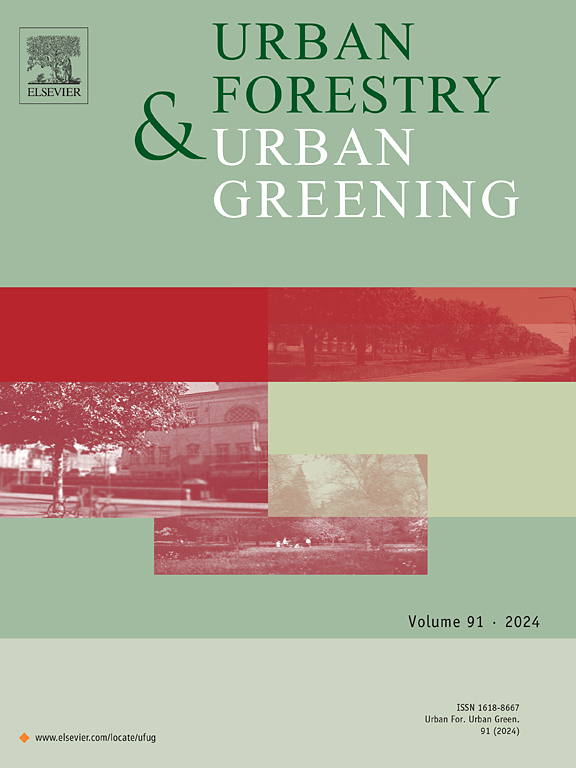美国 10 个都会区的公平、旅行和公园游览情况:智能手机移动性研究
IF 6
2区 环境科学与生态学
Q1 ENVIRONMENTAL STUDIES
引用次数: 0
摘要
城市规划者和城市林业研究人员使用各种方法来评估不同人群享受公园益处的程度,通常是通过评估公园分布与周边社区社会和经济条件的关系。然而,由于没有精确的游览数据,人们仍不清楚公园的邻近程度是否会转化为实际使用情况。本研究利用多个城市和生态环境中的真实数据,分析了影响公园游览的社会和空间因素。我们利用智能手机的移动性获取了美国 10 个大都会区 14,000 多座公园的游览人数,这些公园代表了 26,000 多个人口普查街区组(CBGs)的人口。通过将人口普查数据与空间模型相结合,我们研究了公园游览量、公园与游客居住区的距离以及种族和民族等社会经济变量之间的关系。我们的分析表明,公园的游览率会随着游客居住地的邻近程度而增加。我们还发现,游览率与游客家庭所在社区的人口密度、收入中位数和公园覆盖率等因素之间存在正相关。此外,我们还发现公园游览率与这些社区的种族和民族构成之间存在明显的相关性。这些研究结果证实了这样一个假设,即距离公园更近的地方会提高游客的游览率。我们建议,在规划公园可达性时,应将公园游览数据与分布分析一并考虑。本文章由计算机程序翻译,如有差异,请以英文原文为准。
Equity, travel, and park visitation in 10 US metro areas: A smartphone mobility study
Urban planners and urban forestry researchers use various methods to evaluate how well different populations access the benefits of parks, often by assessing park distribution in relation to the social and economic conditions of surrounding neighbourhoods. However, without precise visitation data, it remains unclear whether proximity to parks translates into actual use. This study analyses the social and spatial factors influencing park visitation using real-world data across multiple urban and ecological contexts. We utilised smartphone mobility to capture visitation counts for over 14,000 parks across 10 US metropolitan areas, representing populations from more than 26,000 census block groups (CBGs). By integrating census data with spatial models, we examined the relationships between park visitation, proximity of parks to visitors' home neighbourhoods, and socio-economic variables such as race and ethnicity. Our analysis revealed that park visitation increases with proximity to visitors' home neighbourhoods. We also found positive associations between visitation rates and factors such as population density, median income, and park coverage in visitors' home neighbourhoods. Additionally, we identified significant correlations between park visitation and the racial and ethnic composition of these neighbourhoods. These findings confirm the assumption that closer proximity to parks enhances visitation rates. We recommend that park visitation data be considered alongside distributional analyses when planning for park accessibility.
求助全文
通过发布文献求助,成功后即可免费获取论文全文。
去求助
来源期刊

Urban Forestry & Urban Greening
FORESTRY-
CiteScore
11.70
自引率
12.50%
发文量
289
审稿时长
70 days
期刊介绍:
Urban Forestry and Urban Greening is a refereed, international journal aimed at presenting high-quality research with urban and peri-urban woody and non-woody vegetation and its use, planning, design, establishment and management as its main topics. Urban Forestry and Urban Greening concentrates on all tree-dominated (as joint together in the urban forest) as well as other green resources in and around urban areas, such as woodlands, public and private urban parks and gardens, urban nature areas, street tree and square plantations, botanical gardens and cemeteries.
The journal welcomes basic and applied research papers, as well as review papers and short communications. Contributions should focus on one or more of the following aspects:
-Form and functions of urban forests and other vegetation, including aspects of urban ecology.
-Policy-making, planning and design related to urban forests and other vegetation.
-Selection and establishment of tree resources and other vegetation for urban environments.
-Management of urban forests and other vegetation.
Original contributions of a high academic standard are invited from a wide range of disciplines and fields, including forestry, biology, horticulture, arboriculture, landscape ecology, pathology, soil science, hydrology, landscape architecture, landscape planning, urban planning and design, economics, sociology, environmental psychology, public health, and education.
 求助内容:
求助内容: 应助结果提醒方式:
应助结果提醒方式:


